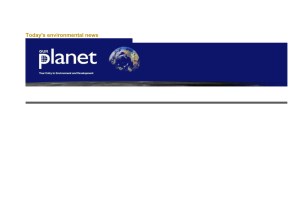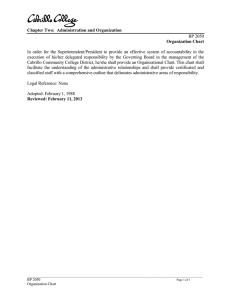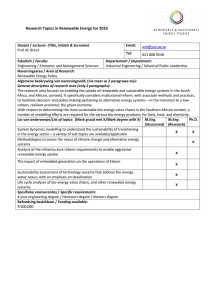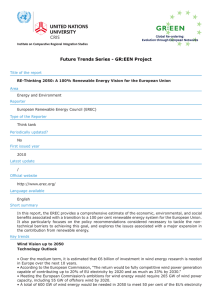Future Trends Series - GR:EEN Project
advertisement
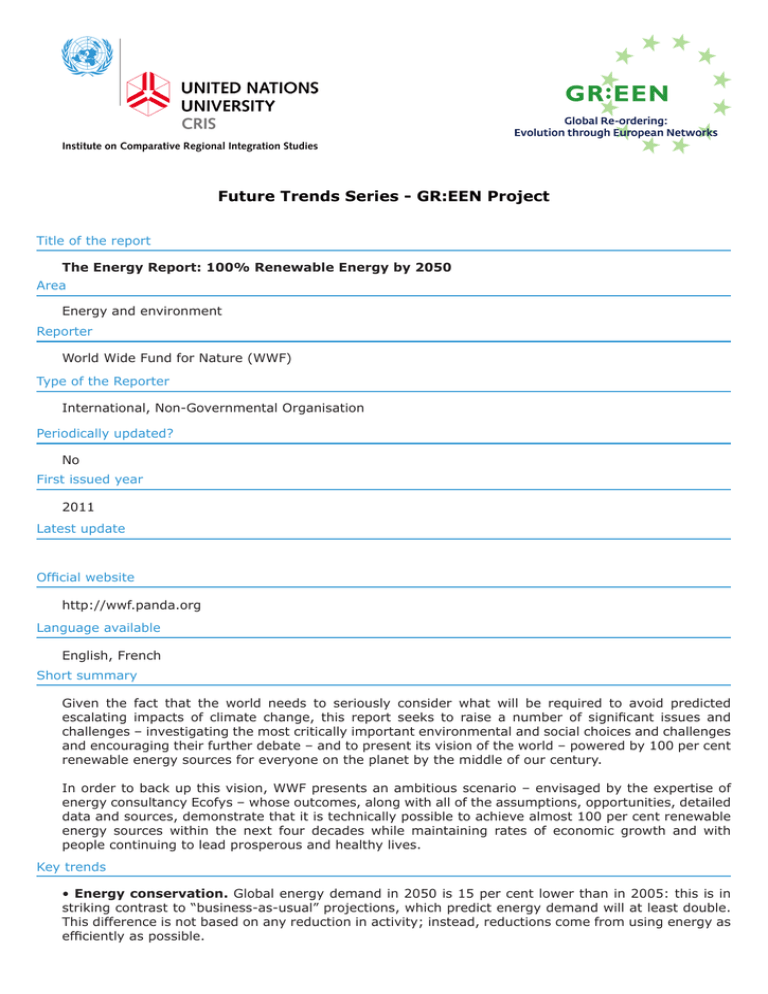
Future Trends Series - GR:EEN Project Title of the report The Energy Report: 100% Renewable Energy by 2050 Area Energy and environment Reporter World Wide Fund for Nature (WWF) Type of the Reporter International, Non-Governmental Organisation Periodically updated? No First issued year 2011 Latest update Official website http://wwf.panda.org Language available English, French Short summary Given the fact that the world needs to seriously consider what will be required to avoid predicted escalating impacts of climate change, this report seeks to raise a number of significant issues and challenges – investigating the most critically important environmental and social choices and challenges and encouraging their further debate – and to present its vision of the world – powered by 100 per cent renewable energy sources for everyone on the planet by the middle of our century. In order to back up this vision, WWF presents an ambitious scenario – envisaged by the expertise of energy consultancy Ecofys – whose outcomes, along with all of the assumptions, opportunities, detailed data and sources, demonstrate that it is technically possible to achieve almost 100 per cent renewable energy sources within the next four decades while maintaining rates of economic growth and with people continuing to lead prosperous and healthy lives. Key trends • Energy conservation. Global energy demand in 2050 is 15 per cent lower than in 2005: this is in striking contrast to “business-as-usual” projections, which predict energy demand will at least double. This difference is not based on any reduction in activity; instead, reductions come from using energy as efficiently as possible. • Electrification. Even though it currently meets less than one-fifth, electricity accounts for almost half of the world’s energy needs by 2050. This is because electricity, as well as heat, are the forms of energy most easily generated by renewables. • Equity. The world’s energy consumption will be more fairly balanced, and traditional and inefficient biomass is phased out by 2035. “From solar power across Africa, to geothermal power in Indonesia, developing countries have great potential to fuel economic growth with renewable energy. Large-scale wind, solar and geo-thermal plants are beginning to appear. Micro-scale renewable used at community or household level also give options to those not connected to an energy grid. Renewable energy offers hope to the hundreds of millions of people trapped in energy poverty”. • Land and sea use. There will be very significant improvements in energy efficiency, through a rigorous assessment of how much land could be available globally to grow bio-fuels to meet the demand for liquid fuels. • Lifestyle. People in the Organization for Economic Cooperation and Development (OECD) countries will be eating half as much meat by 2050, while meat consumption increases by a quarter elsewhere. Wasting less food, particularly in rich countries, will also save energy and free up more land. Moreover, personal mobility is also predicted to rise by 2050. The world can manage this increase by a substantial shift to less polluting forms of transport. • Finance. Renewable energy makes long-term economic sense, saving nearly €4 trillion a year by 2050 through energy efficiency and reduced fuel costs, without even taking into account the costs saved from slowing catastrophic climate change, nor the added value of the millions of jobs created, or health and social benefits like better air quality and well-being. • Innovation. Since new technologies and processes will appear and be tested, there is an opportunity to further increase the proportion of renewable energy from 95 to 100 per cent and to reduce the need for bio-fuels and the pressure this puts on food and water supplies and the natural world. Suggestions • Energy conservation. Individuals, businesses and communities need to reduce demand by improving energy efficiency – through legally binding minimum efficiency standards and criteria – and reducing wasteful use of energy. • Electrification. The use of electricity and direct heat must be maximised with improvements to electricity smart grids to support this. • Equity. Changes in lifestyles have a critical role to play: developing countries need investment to develop their own renewable energy capacity; countries with advanced renewable energy technology need to share their knowledge and expertise with developing countries. • Land and sea use. Strict criteria are needed to make sure that any bio-energy used comes from sustainable sources and is directed to the sectors of the economy that need it most; thus, careful and precise planning is needed. • Lifestyle. Every individual needs to be more aware of the impact their lifestyle has and what they can do about it; public policy should help direct people to make wiser choices. • Finance. Global capital expenditure of €1 trillion a year is needed, growing to around €3.5 trillion a year over the next 25 years: this is because moving to a renewable future will mean rethinking our current finance systems. • Innovation. Global expenditure on Research & Development for renewable energy and efficiency must double over the next ten years. • Governance. “Local, national and regional governance will need to be greatly strengthened to secure an equitable energy future.” International cooperation and collaboration is needed on an unprecedented level in order “to bridge the gap between energy-rich and energy-poor, both within and between countries”. Methodology Research from secondary sources Reference to other trends reports? If yes, which reports? - BTG 2004, “BIO-ENERGY’S ROLE IN THE EU ENERGY MARKET - A view of developments until 2020” Report to the European Commission, Enschede, Netherlands. - CCC, 2009, UK Committee on Climate Change, (2009), “Meeting the UK aviation target – options for reducing emissions to 2050”. - ECF, 2010, “Roadmap 2050 – A Practical Guide to a Prosperous, Low-Carbon Europe”, European Climate Foundation, The Hague, 2010. - FAO, 2006, “World agriculture: towards 2030/2050 - Prospects for food, nutrition, agriculture and major commodity groups”, Global Perspective Studies Unit Food and Agriculture Organization of the United Nations, Rome, June 2006. - SHELL, 2008, “Shell scenarios to 2050”, Shell International bv, (2008), Energy scenarios: Scramble and Blueprints.
